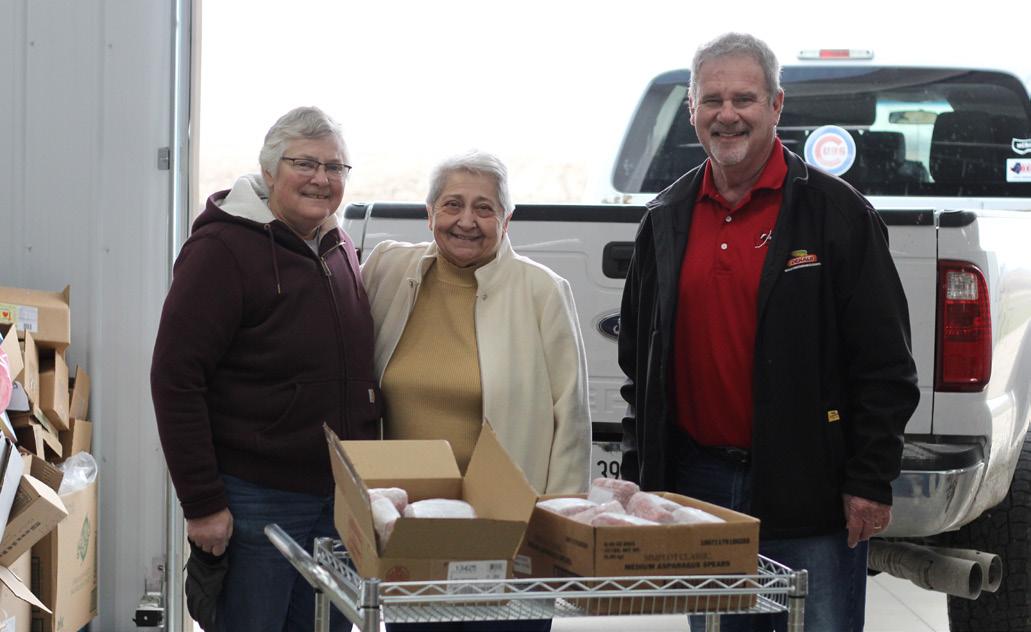
7 minute read
Gate Cuts
Paul Walker, DI Walker Consulting
Thoughts on Replacement Heifer Selection
Advertisement
Currently, it is the middle of the May-June calving season, but it will not be long until we are weaning winter born calves and making decisions regarding which heifer calves to keep as replacements. To that point, I recently read a well-written article that cited 11 criteria upon which to base replacement heifer selection. Over the 33 years that I taught Beef CowCalf Production, Beef Cow-Calf Management and Feedlot Management courses I learned that book recommendations too often do not match real-world scenarios. The fact is, there is not much flexibility to utilize selection criteria for keeping replacement heifers because the numbers dictate a culling only scenario. What do I mean?
Let us assume a 100-cow herd that culls 20% of the cows each year (open, lame cows, old cows, poor milking cows, and the occasional dead cow). Assume a calf crop weaned percent is 90% (the U.S. average is closer to 85%-USDA statistics). Accordingly, there are 45 heifer calves to consider for replacements. Regarding the 20 cows culled each year, a good practice is to keep 50% more replacements than needed as calving 2-year-olds. In this scenario, 30 heifer calves should be kept as potential replacements; as additional culling of the replacements will occur 1) as yearlings prior to breeding. 2) 90-120 days following breeding and 3) maybe again as bred heifers. Notice I have used the word culling up to his point because no selection has been accomplished. Heifers have been discarded because they are open, unsound or have a physical/disposition problem. No selection criteria based on performance or genotype have been utilized so far in this discussion as replacement heifer selection has been strictly a numbers game unless all of the 30 heifers become pregnant and have no soundness nor disposition problems. Only then does the cattleman have an opportunity to utilize selection criteria.
Of the original 45 heifers available, 30 were required to meet the 20, bred 2-year-old number needed. Accordingly, the only selection opportunity is which 15 heifers will not be kept, but this number may be only 7.5 (8) heifers. Most authors recommend keeping only those heifers that were born during the first half of the calving season because those born during the last one-half may not have an opportunity to cycle at least twice before breeding time as yearlings. Therefore, of the 45 heifers weaned, selection criteria [such as EPD traits, phenotype/conformation, frame score, pelvic area measurement, fleshing ability, etc.] could only be utilized for 8 heifer selections. Consequently, for a commercial herd the only real chance to make genetic improvement comes from the choice of sire. This is why selection of potential herd bulls is such an important decision. And, sire selection should always be considered an investment, not an expense.
Yes, I have implied little selection occurs on the cow side of the equation. Of the 100 cows that calved 10 did not wean calves. In commercial herds, in most years, cows that do not wean calves should be culled. There are exceptions that can be affected by such things as drought, cost of feed, value of cows versus the value of heifers, etc. Ten additional cows are culled each year because they are open, unsound, have poor udders and/or they are old. Almost always an open cow should be culled because economics seldom justify keeping an open cow, but there can be exceptions (the bull becomes infertile during breeding season, etc.). None of the factors listed involve selection. These reasons for removal are an either/or situation. Either they are kept, or they are culled. Either they are bred, or they are not. Either they weaned a calf, or they did not. Either they are sound, or they are not. Either they have a good udder, or they do not. Therefore, I repeat myself, “the only real chance for a commercial herd to make genetic improvement is from the choice of sire selected. “Of course, there are exceptions the Book did not state, or the Professor forgot to mention. I will write about those in another article.

Affiliate News
Heartland Beef Alliance
The Heartland Beef Alliance partnered with Menard County Farm Bureau and Greenview United Church to donate 225 lbs. to the Anthens Area Food Pantry, Greenview Food Pantry and Petersburg Community Action.

Rod Leman, Greenview Food Pantry president; Connie Leman, Greenview Food Pantry volunteer; Ann Broch, Greenview Food Pantry volunteer; Larry Eimer, Heartland Beef Alliance vice president; and Betsy Pech, Heartland Beef Alliance president. Betsy Pech, Heartland Beef Alliance president; Linda Pedigo, Athens Area Food Pantry vice president; and Larry Eimer, Heartland Beef Alliance vice president.

Summer CalendarAffiliate
Jo Daviess County Beef Association Banquet June
The banquet will include a prime rib dinner during the annual beef promotion and scholarship auction. Location is TBD.
The banquet will be held at Lavender Crest Winery. Contact Taryn Johnson or visit the Henry County Beef Association Facebook page for additional details.
Bureau County Cattlemen “Beef and Ag Festival” Saturday, June 19
The festival will be held at Soldiers and Sailors park. Steak sandwiches, beef hot dogs and hamburgers will be served from 11:00 a.m. to 7:00 p.m. Entertainment will be provided.
Tri-County Affiliate Banquet and Educational Tour Saturday, August 28
Location is TBD.
Affiliate News
Do you have Affiliate News? Submit information to Betty Haynes at betty@illinoisbeef.com or 217-787-4280. Please notify Betty as changes to affiliate officer teams are made for our records.
In the Know
Applications Available for Veterinary Student Loans
Illinois Farm Bureau® (IFB) is accepting applications for its Illinois Veterinary Education and Training (IVET) loan program. Loans are available to second-year veterinary students attending any accredited college of veterinary medicine in the U.S. and who are focused on Illinois food animal medicine.
The Illinois Veterinary Education Training (IVET) Program helps offset the high cost of veterinary education. The program loans up to $40,000 to as many as three veterinary students each year. Loans are made over a period of two to three years. IVET awards recipients a $1,500 stipend during their fourth year in school to help pay expenses associated with clinical rotations. Loans are repaid over five years, during which graduates must commit to working in a food animal practice that services Illinois livestock producers. “Illinois Farm Bureau encourages veterinary students to pursue a career in caring for food animals,” said Tasha Bunting, associate director of commodities & livestock practices, IFB. “To succeed, farmers need the services of a food-animal veterinarian to help them care for their beef cattle, swine, sheep and poultry. It’s an incredibly rewarding career field that has seen an increase in demand in recent years.” Applications are due May 15, 2021 and can be found online at www.ilfb.org/IVET. The selection committee will interview eligible applicants in spring 2021. Successful applicants will be notified by mail. Loan disbursements begin in August. IFB established IVET in 2005. Since then, the organization has awarded more than $510,000 to 26 veterinary students who focus on caring for food animals in Illinois.
For more information about the program, contact Tasha Bunting at 309-557-2993 or tbunting@ilfb.org.
NCBA Backed Study Proves Stepped-Up Basis Repeal Would Be Detrimental to Farms and Ranches
The Family Business Estate Tax Coalition (FBETC) released an EY study quantifying the impact a repeal of stepped-up basis would have on family businesses. The National Cattlemen’s Beef Association (NCBA) has long advocated for the preservation of this long-standing provision of the U.S. tax code, as well as other sound tax policies for rural America, and has been an active supporter of this study. “The EY study sheds light on the facts that we at NCBA—among others in the agricultural community—have long known. Simply put, the repeal of stepped-up basis would have catastrophic impacts on the ability of farmers and ranchers to transfer their operations to the next generation,” said NCBA Senior Executive Director of Government Affairs Danielle Beck. The EY study found that family-owned businesses and the local economies they support would be hit hardest by a repeal. To reveal the impact stepped-up basis repeal would have on family-owned farms and ranches, EY developed a case-study based on a theoretical family-owned cow-calf operation. In this scenario—one where the stepped-up basis is no longer a tool for family-owned business to utilize when generational transfer occurs — gains are taxed at death and would result in an immediate one-time tax liability equivalent to 280 percent of the farm’s annual income. “NCBA continues to advocate for tax policy that allows the next generation of agricultural producers to have the economic tools to be successful. Repealing stepped-up basis would adversely impact farmers and ranchers across the country.” said Beck.










